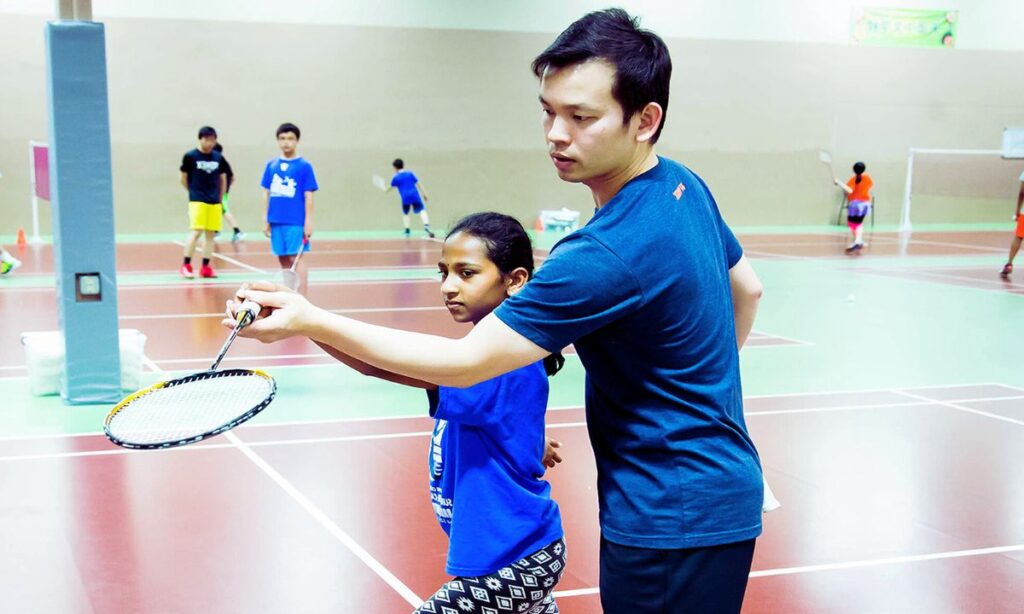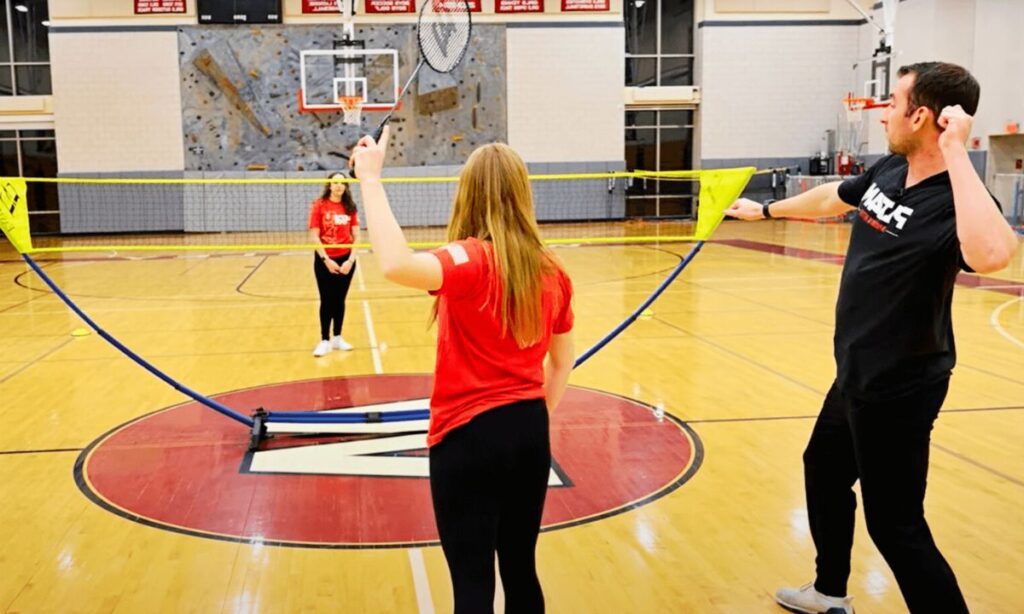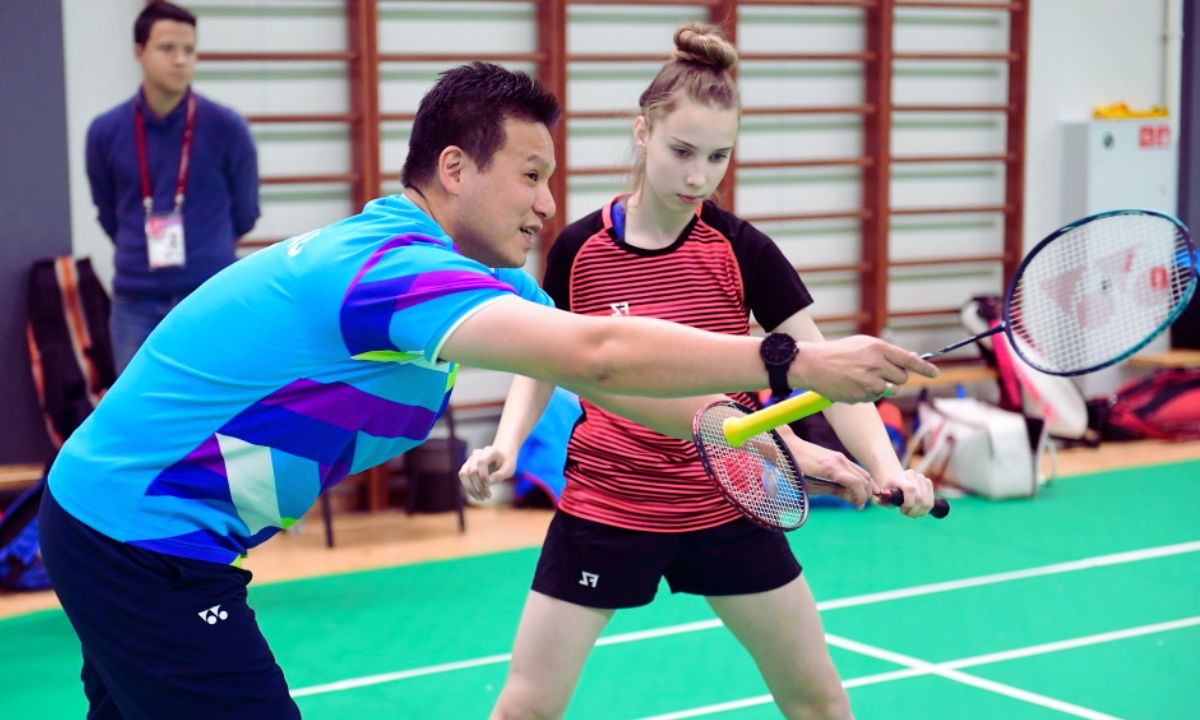Badminton skills go beyond just hitting a shuttle back and forth. They define how well you move, react, and control the pace of a match. Whether you’re a casual player or aiming for competitive levels, improving your badminton skills can drastically elevate your performance. From basic grip techniques to advanced footwork and game sense, mastering these skills will make you more confident and consistent on the court. The right skills also reduce the risk of injury and help you outlast opponents in long rallies. Understanding what these skills are is the first step toward mastering the game.
The Importance of Footwork in Badminton Skills
One of the most overlooked but essential badminton skills is footwork. It’s the foundation of every shot you make. Good footwork lets you reach the shuttle quickly, maintain balance, and be in the right position to play an effective stroke. Without solid footwork, even the best racket technique won’t help. Practicing movements like the split-step, side shuffle, and lunge improves your court coverage. Remember, badminton is a fast-paced game. Every second counts, and efficient footwork can give you the edge you need to turn defense into attack.
Mastering the Grip: The First Badminton Skill to Learn
Getting your grip right is the first real step toward developing better badminton skills. A proper grip helps you control your shots, apply spin, and avoid injuries like tennis elbow. The two most commonly used grips are the forehand and backhand grips. Mastering the basic grip positions allows you to transition smoothly between different strokes. Beginners often hold the racket too tightly, limiting flexibility. A relaxed but firm grip offers more control. Practice holding your racket correctly every time you play—it’s a small habit that pays big dividends in the long run.

Smash Techniques: Adding Power to Your Game
The smash is one of the most powerful offensive shots in badminton. It’s a skill that intimidates opponents and earns quick points when executed well. A great smash isn’t just about brute strength—it involves timing, wrist snap, angle, and body rotation. Work on your jump smash to add vertical power and surprise your opponent. Keep your elbow high and follow through to maintain direction and force. Smashing takes energy, so use it strategically rather than overdoing it. When used wisely, it becomes a key weapon in your skill set.
Drop Shots: Mastering the Art of Subtlety
While smashes showcase power, drop shots are all about finesse. A well-placed drop shot can completely throw off your opponent’s rhythm. It’s especially useful when they’re positioned deep in the court. The idea is to make the shuttle fall just over the net, forcing your opponent to rush forward. To develop this skill, practice your touch and racket angle. Don’t flick your wrist too much—gentle control wins here. A good drop shot adds variety to your game, making it harder for opponents to predict your next move.
Net Play: The Unsung Hero of Badminton Skills
Net play may not seem flashy, but it’s one of the most strategic badminton skills. Winning at the net can tilt the match in your favor by forcing errors or setting you up for a smash. A tight net shot creates pressure and limits your opponent’s shot options. To excel here, stay low and use a soft grip for better control. Watch the shuttle carefully and practice net kills to capitalize on weak returns. Great net play often wins crucial points in tight games. Don’t ignore it in your training routine.
Improving Your Backhand: A Game-Changing Skill
Many beginners struggle with backhand shots because they require a different grip and wrist action. However, mastering the backhand is essential for a well-rounded game. It lets you handle awkward shots and defend tough angles, especially on your non-dominant side. Start by learning the correct backhand grip and practice your swing with slow, controlled motions. Backhand clears, drives, and drops should be part of your regular drills. The more you practice, the more natural it becomes. Once comfortable, your confidence during rallies will skyrocket.
Building Stamina and Endurance for Longer Rallies
Stamina is a critical yet underrated badminton skill. Matches can be physically demanding, especially in tournaments where you may play several games a day. A lack of endurance affects your footwork, reaction time, and shot accuracy. Incorporate cardiovascular exercises like skipping, jogging, and interval training into your routine. Plyometrics and strength training can also help with explosive movements. The goal is to stay sharp and agile deep into the game. With better stamina, you’ll not only outlast your opponent but also make smarter decisions under pressure.
Shot Variety: The Key to Unpredictable Gameplay
One of the most effective badminton skills is the ability to mix up your shots. If you become predictable, even an average opponent can read your game and respond easily. Practice a wide range of shots including clears, drops, drives, smashes, and net shots. Use deception in your body language to keep your opponent guessing. For instance, simulate a smash but play a drop shot instead. This kind of unpredictability gives you control over the pace and direction of the match, making it harder for your opponent to settle in.
Learning to Read Your Opponent
Understanding your opponent’s playing style is a skill that separates average players from great ones. Observation is key. Watch how they move, their shot preferences, and how they handle pressure. This insight lets you exploit their weaknesses and adjust your strategy mid-game. Are they weaker on the backhand? Do they tire easily? Use that information to gain the upper hand. Reading your opponent isn’t just physical—it’s mental. With experience, this skill becomes second nature and often becomes the deciding factor in close games.
Game Strategy: Beyond Just Hitting the Shuttle
A smart player always plays with a plan. Strategy is one of the most overlooked badminton skills among new players. Know when to attack, when to defend, and how to change the tempo. For example, a fast-paced start may overwhelm a slow starter, while a more patient approach might frustrate aggressive players. Your strategy should evolve during the game based on how your opponent responds. Think two or three shots ahead. Strategy isn’t about complex play—it’s about making the right decision at the right moment.
Warm-Up and Cool-Down: Supporting Your Skills
Developing badminton skills isn’t just about practicing shots. Proper warm-up and cool-down routines play a crucial role in performance and injury prevention. Warming up activates your muscles, increases blood flow, and gets your mind ready. Dynamic stretches, short sprints, and light footwork drills are great before a game. After playing, cool down with static stretches and hydration to help your body recover. These habits might seem small but they keep you healthy, consistent, and ready to train another day. Every serious player swears by them.
Practicing with Purpose: Quality Over Quantity
It’s easy to fall into the trap of mindless repetition. Real improvement in badminton skills comes from focused practice. Each session should have a clear goal—whether it’s improving your net play, refining your backhand, or building stamina. Use drills that mimic match situations, and take time to analyze what’s working and what isn’t. Record your practice or matches to identify areas for improvement. Also, get feedback from coaches or more experienced players. The goal is not just to practice hard, but to practice smart and with purpose.
Mental Toughness: The Invisible Badminton Skill
Physical ability alone won’t carry you through tight matches. Mental toughness is an underrated badminton skill that makes a big difference. Staying calm under pressure, bouncing back after a mistake, and staying focused through long rallies are mental skills worth developing. Visualization, breathing exercises, and positive self-talk can improve your mental game. Learn to let go of a lost point and move on to the next one. A strong mind can often beat a stronger body, especially when the match goes down to the wire.
Smash Placement: Power Means Nothing Without Precision
A smash alone won’t win you points unless it’s accurately placed. Too many players rely solely on power, ignoring the angles. A smash aimed at your opponent’s body or the sidelines is much harder to return than one directly at their racket. Train yourself to hit smashes into the corners or at chest level to jam their responses. Also, switch up between cross-court and straight smashes. Placement adds a layer of strategy to your attacking shots. When you learn to combine power with accuracy, your smash becomes a fearsome skill instead of just a flashy move.
Drive Shots: Speed Up Your Midcourt Game
Drive shots are fast, flat strokes that travel parallel to the net and are especially effective in doubles. These shots keep your opponent under pressure, reducing their time to react and respond. Drives are a great way to transition from defense to offense or maintain aggressive momentum in a rally. Work on wrist strength and reflexes to improve drive consistency. Also, use forehand and backhand drives interchangeably to remain unpredictable. When your drive game is sharp, you dominate the midcourt and control the rally’s tempo without overexerting yourself.
Defensive Skills: Learning to Stay Calm Under Fire
Everyone loves a great offense, but defense is what keeps you in the game. Defensive badminton skills like lifts, blocks, and clearances let you reset rallies and frustrate aggressive opponents. Staying calm during a fast-paced exchange is crucial. Learn to use your opponent’s power to your advantage—especially during smashes. Soft block returns or high defensive clears give you breathing room to recover. Remember, defense isn’t just about surviving—it’s about waiting for your moment to strike. Good defenders force attackers into mistakes and create opportunities for counterattacks.
Timing and Rhythm: The Hidden Layers of Mastery
Timing is often the difference between a clean shot and a mishit. Perfectly timed strokes feel effortless and fly with precision. Practicing rhythm-based drills can help you improve shot timing, particularly during rallies. Don’t rush your shots—wait for the shuttle to reach your ideal strike zone. This requires patience, awareness, and understanding shuttle speed. Timing also applies to movement. Step too early or too late, and you’ll lose balance. Work on syncing your body’s movement with the shuttle’s flight. The more in rhythm you are, the more fluid your game becomes.
Shadow Practice: The Secret Weapon of Top Players
Shadow practice is one of the simplest yet most effective ways to improve badminton skills. It involves practicing movements and footwork without a shuttle, helping you build muscle memory and court awareness. By repeating split steps, lunges, and directional shifts, you refine your motion without the pressure of a game. This is especially useful for solo training sessions. Top-level athletes use shadow drills to improve their speed, agility, and form. A few minutes of focused shadow practice each day can sharpen your movement and set the foundation for better on-court execution.
Improving Reaction Time: Gaining the Edge in Fast Rallies
Badminton is a lightning-fast game, and reaction time is everything. A fraction of a second delay can cost you a point. Improving this skill involves training both your eyes and your body to respond quickly. Multi-shuttle drills, fast-feed drills, and reaction ball exercises can all boost your reflexes. Also, playing against faster players helps you adjust to real-time speed. Stay alert, keep your knees slightly bent, and maintain a neutral stance to react quickly. As your reaction time improves, you’ll find yourself anticipating shots before they even land.

Shot Recovery: What You Do After Hitting Matters
Many players focus only on making the shot, forgetting the importance of what comes next—recovery. After every stroke, your job is to return to a neutral or ready position that allows you to cover the court again. Good shot recovery is essential in keeping up with fast rallies. If you admire your smash instead of repositioning, you’ll be caught off guard. Practice routines that include returning to center after every shot. With solid recovery habits, you’ll spend less energy chasing the shuttle and more time dictating the flow of play.
Use of Deception: Outsmart Rather Than Outplay
Deception is a skill that adds intelligence to your game. Faking a clear and playing a drop shot or pretending to smash and then slicing the shuttle are ways to fool your opponent. Deceptive shots disrupt rhythm and force errors. Learn to disguise your strokes by changing grip pressure, wrist position, or swing angle at the last moment. It takes practice, but once mastered, deception turns you into a more unpredictable and frustrating player to face. Rather than just playing harder, deception teaches you to play smarter.
Practicing with Partners of Varying Skill Levels
Playing with different skill levels is one of the most underrated ways to develop all-around badminton skills. Playing against beginners forces you to focus on consistency and placement. Against equal-level players, you work on strategy and competitive instincts. And facing stronger opponents pushes you to be quicker, sharper, and more adaptive. Each matchup brings a unique challenge and learning opportunity. Don’t limit yourself to familiar opponents. Seek out diverse partners and matches to broaden your skill set. It’s not just about winning—it’s about learning something from every game.
Using Video Analysis to Sharpen Your Skills
Recording your matches or practice sessions can reveal details you miss in real-time. Watching your gameplay helps you understand movement patterns, shot selection, and tactical mistakes. Are you returning to center late? Are you always lifting when under pressure? Video analysis exposes habits and gaps in your skill set. Even professional players use this tool to refine techniques. You don’t need high-end gear—your phone is enough. By analyzing footage, you gain clarity, adjust your training, and become more intentional with how you develop your badminton skills.
Game Anticipation: Reading the Opponent’s Play
Anticipation is a high-level badminton skill that can give you an edge before your opponent even hits the shuttle. Skilled players don’t just react—they predict. This comes from watching the opponent’s body language, racket position, and previous shot patterns. The more you play, the more you develop a natural instinct for where the shuttle is going. Building this kind of anticipation helps you move early, saving valuable time and placing you in better positions for your next shot.
Conditioning and Agility: Building a Fitter Badminton Body
Badminton demands bursts of speed, quick lunges, and long rallies. That’s why physical conditioning is a badminton skill in itself. Players need strong legs for jumping, a stable core for balance, and good endurance to last through matches. Agility drills like ladder runs, cone zigzags, and shuttle sprints are essential. Even yoga and pilates can help improve flexibility and injury prevention. Without good physical conditioning, even the most skilled player can get worn down quickly.
Tactical Shot Selection: Choosing the Right Shot at the Right Time
Knowing how to execute a shot is one thing; knowing when to use it is another. Tactical awareness is a smart badminton skill that involves choosing shots based on your opponent’s weakness, court position, and the rally situation. Should you clear, drop, drive, or smash? Sometimes a soft shot creates more pressure than a hard hit. Players who develop this awareness can build smarter rallies and force opponents into uncomfortable situations, leading to more chances to win points.
Building Confidence Through Match Play
You can train all day in a controlled environment, but true mastery of badminton skills comes through match play. Playing against different opponents with varying styles tests your adaptability and reveals your strengths and weaknesses. Confidence is built by pushing through tough rallies, trying new strategies under pressure, and learning from your mistakes. Match experience teaches resilience, mental toughness, and composure—traits that practice alone can’t fully develop.
Reviewing Performance: Learning from Wins and Losses
After every match or training session, take time to reflect. Watch recordings if possible, or write down what went well and what didn’t. This habit helps you identify which badminton skills need more attention. Maybe your drop shots were sharp, but your footwork lagged in long rallies. Reviewing performance ensures that you’re not just practicing blindly but improving with intention. It’s a habit every serious player should build to track progress and stay motivated.
Consistency: The Glue That Holds Skills Together
No badminton skill matters if it’s not consistent. Hitting a perfect smash once doesn’t help if you miss the next three. The key to mastering badminton skills is repetition and patience. Consistency turns good players into great ones. Focus on mastering the basics before chasing trick shots. Celebrate small wins, track your progress, and push yourself without burning out. Remember, even world champions once struggled with the same skills you’re working on. Stick with it, and your effort will turn into mastery over time.

